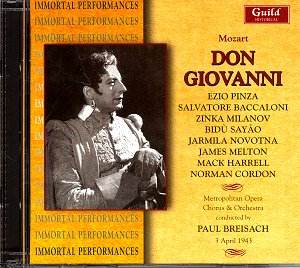In this performance the Met is on tour to Chicago
with a production which had opened under Bruno Walter in 1942
with Ezio Pinzaís famous Don and a generally similar cast (CDs
of this are available). The point of the present issue is that
it gives us Pinzaís most famous partner as Leporello, Salvatore
Baccaloni, in better sound than the 1944 broadcast under Georg
Szell, which has also been transferred to CD, and Zinka Milanovís
only preserved broadcast of a Mozart opera.
This is not quite the great deal it sounds. Pinza
and Baccaloni are indeed wonderful in their recitatives, the words
of their native language flashing vividly from their tongues,
but Baccaloni is in coarse voice in his catalogue aria, which
also reveals a few intonation problems. He is better later but
it would seem that it was not exactly for the singing as such
that his performance was so highly regarded. As for Milanov, she
goes for Donna Anna as if she were a Verdi heroine, her tone uncontrolled
and, in the first Act in particular, frequently sharp. Though
the swooning style is still wrong, her Bellinian rendition of
Non mi dir does at least provide some of the soft singing
and beautiful tone for which she was renowned. All in all it seems
there were good reasons why RCA, for whom she recorded many operas
by Verdi and the like, looked elsewhere for their Mozart sopranos.
Her shortcomings are all the more obvious when both Novotna and
Sayáo (after an uneasy start) are thoroughly stylish. Sayáo
has also great charm and a real personality, so that Zerlina assumes
a more central role in the opera than is often the case.
The other difference from 1942 is, of course,
that Bruno Walterís place was taken by one Paul Breisach. The
booklet gives extensive (and very interesting) notes on the performance
and short biographies of each singer, but no information about
this gentleman is forthcoming. [see Editorís Note]. I presume
he was an assistant who conducted rehearsals and the odd performance
when the great man was away. He takes some pretty fast tempi,
which would be all right if he breathed with his singers, but
instead he barges on. At least some of Baccaloniís problems seem
to stem from this and even Pinza has a job to keep up in the champagne
aria. The women assert themselves rather better; Novotna gently
nudges him towards the tempi she wants and Sayáo forces
him to accompany her in one of the most beautifully shaped performances
of Batti, batti Iíve heard. To be sure, he moves ahead
when the orchestra has a few bars on its own but she always gets
her tempo back when she re-enters. Slow tempi, on the other hand,
sometimes drag, notably the introduction to Vedrai carino which
is far from Grazioso, so this time Sayáo has to
move him on. But I donít want to make too much of this since the
magic of a theatrical occasion is certainly there and I daresay
the players mostly looked the other way and played the Walter
interpretation.
Pinzaís suave charmer of a Don is certainly worth
having, though in view of the existence of the Walter performance
this may not be the best way to get it; Melton and Harrell are
nothing very special.
In common with their general policy Ė a long
letter in defence of which from Richard Caniell can be found on
the site Ė Guild have provided missing portions from other
sources, using the same singers as far as possible. I remain unconvinced.
Those seeking a listener-friendly version will not be choosing
in the historical bracket at all, and issues like this are surely
intended for dedicated opera buffs who want to study Ė rather
than just sit back and listen Ė performances that cannot be heard
on other versions. As far as I am concerned, if itís a broken
torso itís a broken torso and Iíd rather have it like that. If
the banquet scene and the beginning of the epilogue are missing
itís a great pity, but nothing is gained by filling them in with,
respectively, the 1944 Szell and the 1936 Glyndebourne recordings,
which the seasoned collector very likely has anyway. Likewise,
if a patch of the scene in Act Two between Don Giovanni, Masetto
and Zerlina suffers from a very bad scratch, Iíd rather endure
it for the sake of what I can hear of the performances than have
it substituted with the 1942 Walter, which I would want to hear
in its own context. Museums nowadays donít try to complete
missing portions of painting and statues which are partially damaged
(indeed, much restoration today is dedicated to removing the work
of 19th Century "restorers" who did just
that); isnít this the same thing?. Still, whether you agree or
not, Guild do at least declare exactly what the interpolations
are; Iím not for a moment accusing them of misleading the public.
Christopher Howell
Editorís Note: Paul Breisach (1896-1952).
A biographical entry: Born Vienna. Studied at the Vienna Academy
of Music. Assistant to Strauss at Vienna State Opera. Conductor
at Mannheim 1921-24. First conducted at the Met in 1941. Also
conducted there during 1945-6 season. Principal conductor of San
Francisco Opera from 1946 until his death in 1952. Recorded extracts
from Wagner operas with Janssen and Melton. Also recorded excerpts
from Grétryís opera Richard Coeur de Lion with Singher
and the Met opera and chorus (Columbia and Victor)
